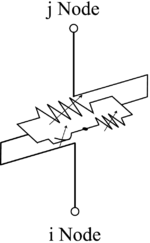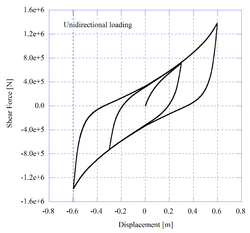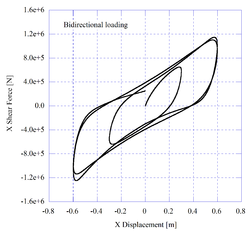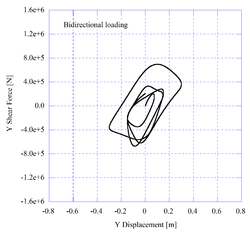YamamotoBiaxialHDR Element
- Command_Manual
- Tcl Commands
- Modeling_Commands
- model
- uniaxialMaterial
- ndMaterial
- frictionModel
- section
- geometricTransf
- element
- node
- sp commands
- mp commands
- timeSeries
- pattern
- mass
- block commands
- region
- rayleigh
- Analysis Commands
- Output Commands
- Misc Commands
- DataBase Commands
This command is used to construct a YamamotoBiaxialHDR element object, which is defined by two nodes. This element can be used to represent the isotropic behavior of high-damping rubber bearing in the local y-z plane.
| element YamamotoBiaxialHDR $eleTag $iNode $jNode $Tp $DDo $DDi $Hr <-coRS $cr $cs> <-orient <$x1 $x2 $x3> $y1 $y2 $y3> <-mass $m> |
| $eleTag | unique element object tag |
| $inode $jnode | end nodes |
| $Tp | compound type |
| = 1 : X0.6R manufactured by Bridgestone corporation. | |
| $DDo | outer diameter [m] |
| $DDi | bore diameter [m] |
| $Hr | total thickness of rubber layer [m] |
| Optional Data | |
| $cr $cs | coefficients for shear stress components of <math>\tau_{r}</math> and <math>\tau_{s}</math> |
| $x1 $x2 $x3 | vector components in global coordinates defining local x-axis |
| $yp1 $yp2 $yp3 | vector components in global coordinates defining vector yp which lies in the local x-y plane for the element |
| $m | element mass [kg] |
NOTES:
1) The valid queries to a YamamotoBiaxialHDR element when creating an ElementRecorder object are 'globalForce', 'localForce', 'basicForce', 'localDisplacement' and 'basicDeformation'.
EXAMPLE:
element YamamotoBiaxialHDR 1 1 2 1 1.300 0.030 0.261 –orient 0 0 1 1 0 0
YamamotoBiaxialHDR_Sample.tcl, YamamotoBiaxialHDR_input_X.tcl, YamamotoBiaxialHDR_input_Y.tcl
REFERENCES:
Masashi Yamamoto, Shigeo Minewaki, Harumi Yoneda and Masahiko Higashino, "Nonlinear behavior of high-damping rubber bearings under horizontal bidirectional loading: full-scale tests and analytical modeling", Earthquake Engineering and Structural Dynamics, 41, 1845-1860, 2012.
Code Developed by: mkiku




